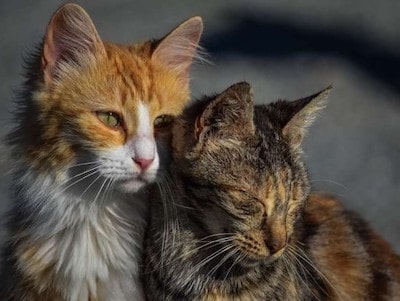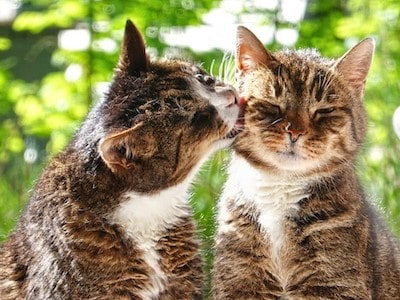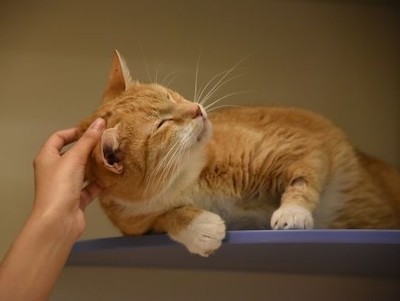Cats are known for their independent nature and aloof behavior, but how do they communicate with humans, especially unfamiliar ones? A recent pilot study conducted by researchers from the Laboratoire Ethologie Cognition Développement at Université Paris Nanterre in France sheds some light on the preferred feline etiquette when faced with an unfamiliar human.
In this article, we’ll explore the study’s findings and discuss the different modes of communication cats use to interact with humans. We’ll also look at practical recommendations for navigating human-cat interactions and improving communication with our feline companions.
The Study: Multimodal Communication in the Human-Cat Relationship
The study, titled “Multimodal Communication in the Human-Cat Relationship: A Pilot Study,” was published in the journal Animals. The researchers examined four modes of human communication – vocal, visual, bimodal (visual and vocal), and a control condition with no communication – with 12 cats living in cat cafés in France.

The study’s aim was to understand how cats respond to different modes of communication and to identify the preferred feline etiquette when faced with an unfamiliar human. By analyzing video clips of cat-human interactions, the researchers found that the modality of communication significantly affected the time it took for cats to approach the human experimenter.
The Results: Cats Prefer Visual and Bimodal Cues
The study’s results showed that cats interacted significantly faster with visual and bimodal communication than with vocal communication alone or no communication. In addition, the communication modality had a significant effect on tail-wagging behavior.

Cats displayed significantly more tail wagging when the experimenter engaged in the no communication control compared to visual and bimodal communication modes, indicating that they were less comfortable in this control condition.
Cats also displayed more tail wagging in response to vocal communication than bimodal communication, suggesting that they were more responsive to vocal cues when interacting with unfamiliar humans. However, overall, the study’s findings suggest that cats prefer visual and bimodal cues when being addressed by non-familiar humans.
Modes of Communication: Vocal, Visual, and Bimodal
Let’s take a closer look at the different modes of communication cats use to interact with humans.
Vocal Communication
Cats use a range of vocalizations to communicate with humans, including meows, purrs, hisses, and growls. Meows are the most common vocalization cats use to communicate with humans, and they can have different meanings depending on their pitch, tone, and volume.
For example, a high-pitched meow might indicate excitement or hunger, while a low-pitched meow might indicate annoyance or frustration. Purring is another vocalization cats use to communicate with humans, and it’s often associated with contentment and relaxation.
However, the study’s results suggest that cats may not be as responsive to vocal communication when interacting with unfamiliar humans. While cats displayed more tail wagging in response to vocal communication than bimodal communication, they interacted significantly faster with visual and bimodal communication than with vocal communication alone or no communication.

Visual Communication
Cats also use visual cues to communicate with humans, such as facial expressions, body posture, and eye contact. For example, when a cat is relaxed and content, they might have a relaxed posture with their tail up and their ears facing forward. When a cat is scared or anxious, they might crouch down with their ears flattened and their tail tucked between their legs.
Eye contact is also an essential aspect of feline communication. When a cat is relaxed and content, they might make direct eye contact with their human companion. However, when a cat is scared or anxious, they might avoid eye contact.
The authors of the study also suggest that understanding cats’ communication preferences may have practical implications, particularly for individuals who work with cats, such as veterinary staff, animal shelter workers, and cat café employees. By utilizing visual and bimodal cues, these individuals may be able to more effectively interact with cats and establish trust and rapport.
Furthermore, this study highlights the importance of understanding and respecting the communication preferences of all animals, not just cats. By taking the time to observe and learn about an animal’s communication cues, we can better understand their needs and desires, which can lead to more positive and fulfilling interactions between humans and animals.
Bimodal Communication
The study found that cats displayed a marked preference for bimodal cues when being addressed by non-familiar humans compared to vocal cues. Bimodal communication involves a combination of visual and vocal cues. It includes using body language, eye contact, and facial expressions, while also making cat-specific calling noises and calling the cat by name.
Pet owners can use bimodal communication to establish a bond with their cats. They can offer a friendly, open hand and make slow blinks while calling their cat by name and making cat-specific calling noises. Additionally, pet owners should observe their cat’s body language to understand their mood and respond appropriately.
No Communication Control
The study also found that cats displayed significantly more tail wagging when the experimenter engaged in the no communication control compared to visual and bimodal communication modes. This finding suggests that cats were less comfortable in the no communication control condition.
Pet owners should avoid the no communication control condition when communicating with their cats. It can cause them to become anxious and agitated. Instead, pet owners should establish a bond with their cats by using visual, vocal, or bimodal communication.
How to Communicate Effectively with Your Cat
As mentioned in the study, cats respond more positively to visual and bimodal cues, rather than just vocal communication. So, what are some effective ways to communicate with your feline friend?
Eye Contact
While eye contact may be an important form of communication for humans, it’s not the same for cats. Direct eye contact can be seen as a threat or challenge to a cat, and can make them feel uncomfortable or anxious. Instead, try to make slow blinks at your cat, which is a sign of trust and relaxation in the feline world.
Body Language
Cats are experts at reading body language, so it’s important to be aware of your posture and movements when interacting with them. A relaxed, open posture and slow movements can help your cat feel more comfortable and at ease.

Vocal Cues
While cats may not respond as strongly to vocal communication alone, there are still some sounds and tones that can be effective in communicating with them. High-pitched tones can be used to get a cat’s attention, while lower, soothing tones can help calm them down.
Touch
Cats are known for their love of physical touch, but it’s important to approach them in the right way. Avoid petting them too roughly or in sensitive areas, and let them come to you for affection. Pay attention to their body language, and stop petting them if they start to show signs of discomfort or irritation.
Treats and Toys
Using treats and toys can be an effective way to communicate with your cat, as they can associate certain behaviors with positive outcomes. For example, rewarding them with a treat or toy when they use their scratching post instead of your furniture can help reinforce that behavior.
Conclusion
While cats may have a reputation for being independent and aloof, they are actually quite social creatures who crave attention and affection from their human companions. By understanding their preferred modes of communication and interacting with them in a way that makes them feel comfortable and relaxed, you can build a strong bond with your feline friend and provide them with the love and care they need.
